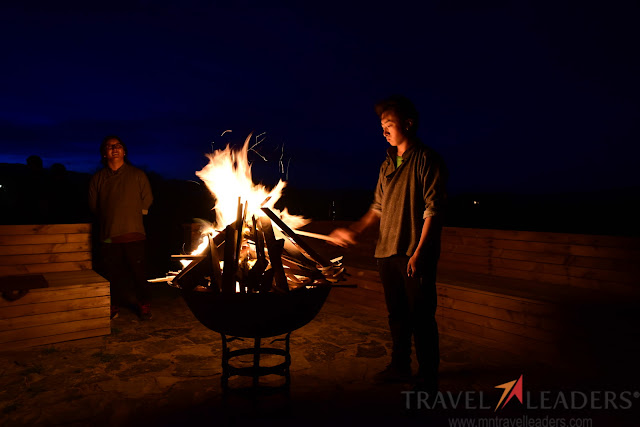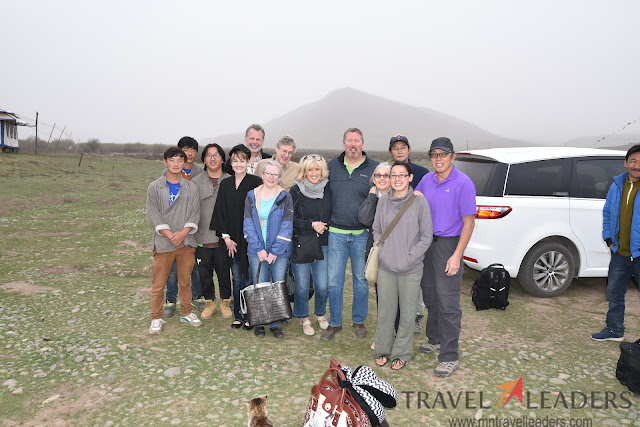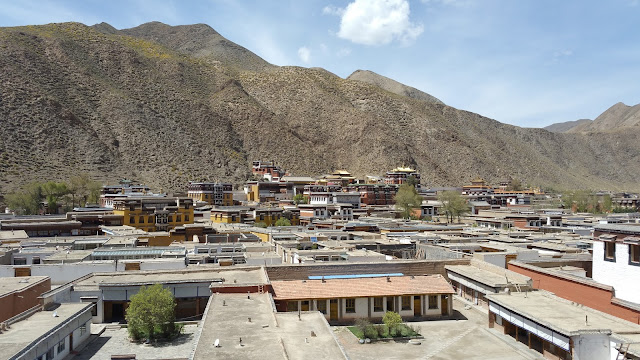Our first night at Norden Camp was memorable. The coal stove in our tent needed some tending overnight, and Sue was able to effectively translate the skills she displays with our wood-burner at home to keep us warm and toasty. That was a good thing, because the overnight low had to be at freezing or just below, considering the frost on the ground the next morning. I rose at dawn, made a dash to the Finnish bathroom and then bundled up for the trek across the camp to the showers.
This is what the morning looked like after I finished the shower: First morning in Tibet.
Breakfast was served in the cabin that also housed the camp's bar. Food was prepared in the kitchen, a nearby building, and brought over for serving buffet-style. A coal stove provided toasty warmth and also cooked the soup. I didn't ask what the soup was, but it was hearty and very good.
 |
| Our first breakfast in Tibet was one to remember. |
 |
| Soup's on, and it was very good. |
 |
| As we were getting to leave for the day's outing, there was time for a photo by the camp's stream. |
Our excursion today would take us back to the town of Xiahe, which we had gone through on the way to the camp the previous day, to visit the Labrang Monastery.
Home to the largest number of monks outside the Tibetan Autonomous Region, the monastery is by the Daxia River, a tributary of the Yellow. Opened in 1709, the monastery at its peak housed some 4,000 monks, but the upheavals of China's Cultural Revolution (1966-76) caused it to be shut down. It reopened in 1980, but the government limits the number of monks to about 1,500. It contains 18 halls and six institutes of higher learning, plus a unique printing house.
 |
| Visitors to the monastery must purchase tickets in the modern reception hall. |
 |
| The intricacy of the reception hall's artwork gave us a preview of coming attractions. (WL) |
 |
| The monastery's buildings blend Tibetan and Indian architecture. |
 |
| You can see the intricate artwork on display. This quality of work was present throughout all the monastery buildings. (WL) |
One building where we were allowed to take interior photos was the butter sculpture room. This will be hard to believe, but each of these photos show sculptures made out of actual yak butter. It takes a team of four monks about 30 days to make one.
 |
 |
| (WL) |
It was nearing 11:30, and our guide, a local fellow named Yan, said we could see the monks being summoned to prayer. We entered a large courtyard which fronted the monastery's main prayer hall, which we had toured earlier. A couple dozen monks were already sitting on the steps, chanting, and more arrived steadily. A number of other residents, mostly women, were seated toward the back of the courtyard where we were. This scene reminded me of what is seen in the movies.
 |
| The monks were wearing the unique headgear from the College of Philosophy. (WL) |
 |
| We had a great vantage point for the call to prayer. (WL) |
Here's a video of the monks chanting, coupled with the closing, when two monks on the roof blew horns to summon their brothers inside: Labrang monks.
 |
| Many of the observers, mostly women, also participated from the periphery. |
 |
| After the monks were called inside, leaving their boots on the steps, the civilians were allowed to join them. |
After leaving the courtyard we were shown the monastery's print shop, called the Barkhang. The monks have produced their own texts for centuries, and the method they use today hasn't changed much in that time. The texts are called sutra, which comes from a Sanskrit word meaning "string" or "thread." In Buddhism, they are considered canonical scriptures, often dealing directly with the teachings of Buddha. The Labrang Monastery has about 60,000 sutras. You can see the monks making them here: Making sutra.
We were allowed into the "library," where the sutras are stored. Like the butter room, it
is climate-controlled and very well-organized.
 |
| (WL) |
We left the monastery grounds and walked toward downtown Xiahe to the Norden Cafe, operated by the same outfit that runs the camp and a factory that produces yak-hair products such as blankets and hats. We were ready for a break and were treated to yakburgers, very tasty, and French fries. The cafe also had WiFi, so most of us took advantage of our first taste of the 21st century in nearly 24 hours to send some emails back home.
China bars access to Facebook, Twitter and all things Google, using what is euphemistically called the "Great Firewall." But being the internet-savvy travelers that we are, we had figured a way around that. I could send emails through Outlook, and so had arranged for our son Jim back home to post my photos and descriptions daily on my social media sites.
 |
| The main drag of downtown Xiahe. |
 |
| At the Norden Cafe, the food was good and we had service with a smile. |
We had one more thing to do at the monastery, and that involved a climb up to the top level of the Gongtang Chorten, a building known as a stupa, which is a special building on a Buddhist monastery. In Tibetan Buddhism, there are eight kinds of stupa, each referring to major events in the life of the Buddha. Up till now we hadn't really felt the altitude, but we sure did as we climbed the staircases. The view was worth it, though.
We left the monastery grounds for the final time and climbed a hill across the road so that we could get another view of the entire campus. It was also a good place to rest. Just to the right of center in the foreground is the Gongtang Chorten, which rises 100 feet above the ground.
 |
| (WL) |
Our guide, Yan, is from Xiahe and wanted to show us some of his town, so we hiked back across the road and strolled through the streets, buying some water from a shop. Bottled water is everywhere in China, and a decent-sized bottle could be had for the equivalent of about 30 cents US.
 |
| The kids, as always, were happy to see us. |
 |
| This pig, though, couldn't have cared less. (WL) |
Most of us had visited countries in the so-called Third World, and parts of China are still there. The contrast between ultramodern Shanghai and relatively-primitive Xiahe was apparent. But it is helpful when traveling in these places to remember that there are some parts of the U.S. that might very well fall into the same category. The important thing, really, is the people, and so far we had found the Chinese people to be friendly and welcoming.
We loaded up in our van for the trip back to camp, having spent a very enlightening day in a fascinating place. At camp, we freshened up and gathered for another memorable dinner, this one served in a dining tent. This is the authentic Chinese "hotpot" method, where pots of boiling water are brought to each table and each diner cooks his own meats and vegetables right there. It's a very healthy meal, as no cooking oils are used and all the ingredients are free of preservatives.
 |
| Sue reacts to the arrival of the hotpot at our table. (WL) |
 |
| Bonnie negotiates some noodles. (WL) |
It was getting late when dinner concluded and tomorrow would be another big day. Some of our group would be hitting the road again, to visit Norden's factory where the yak products were produced. The rest of us, including me and Sue, would be indulging our inner Indiana Jones, as we would be mounting horses and heading up into the foothills of the Himalayas. We could hardly wait.
Wednesday, May 11 -- Norden Camp
This was the day I had been waiting for. I've been a horseback riding aficionado for many years, and although I don't have my own horse or ride as much as I'd like, I'd been able to ride in many states of the American West, not to mention in our own state of Wisconsin, and in the Canadian Rockies. Most of these riding adventures were with Sue. Now, we would get to ride in China.
The camp contracted with some nearby nomads to provide us with horses and guides for the day. There would be five of us: myself and Sue, Dave Hershberger, and Walt Lee and his daughter Bridget. The remaining four members of our group were taking a day-long trip to tour Norden's factory. The weather was perfect as our guides arrived with the horses.
Tibet's nomad culture goes back centuries. These hardy people live off the land, grazing their sheep and cattle, living lives that are about as simple as a 21st-century person could have. In the last couple decades their lifestyle has been threatened as the Chinese government seeks to move them off the grasslands into towns and villages. The government cites environmental concerns from the over-grazing of the grasslands that form the watersheds of three massive river systems: the Yellow, Yangtze and Mekong. Many environmentalists dispute the government's view.
 |
| A nomad encampment, just down the road from Norden Camp. (WL) |
 |
| A Tibetan herds his sheep along the road that passes the camp. (WL) |
We had seen large high-rise apartment complexes on the outskirts of Lanzhou and all throughout Shanghai; many of those in the Lanzhou environs are largely empty of inhabitants, and while we didn't see the same types of buildings in Xiahe, it's not hard to imagine that the government could indeed decide that what's best for these people is not the way of life they've practiced for centuries, but something the bureaucrats in Beijing decide for them. In China, decisions about these things are made at the top, and those on the bottom or in the middle have little or no say, at least by comparison to what we have in America.
But the three nomads who brought the horses to our camp weren't there to talk about environmentalism or politics, and neither were we. In fact, the nomads comprised three generations: a grandmother, her daughter and granddaughter. None of them seemed to know any English, but fortunately Bridget knew some Chinese from an earlier stay in Shanghai. Where we were going, language barriers were not a problem, though.
 |
| Grandma leads us down the road from camp... (WL) |
 |
| ...while Granddaughter takes the lead of Walt's horse. (WL) |
 |
| Sue and I have been on horseback in the States and Canada, but this was a real treat. (WL) |
 |
| Dave H brought his trusty camera along, too. (WL) |
 |
| Negotiating a small creek required Sue to dismount while Grandma persuaded her horse to cross. (WL) |
 |
| The little girl tuckered out quickly, and Bridget was happy to help her out. (WL) |
 |
| Heading back, she wanted to sit up front. (WL) |
 |
| Sue's horse occasionally required some extra help from Mom. (WL) |
 |
| The ladies were all smiles. Us gents, too. (WL) |
 |
| Bridget got this shot of Walt with the magnificent vista of Tibet behind him. According to the altimeter app on his phone, we had reached 11,000 feet on the ride. (WL) |
 |
| It looks desolate, but there was life everywhere. (WL) |
When we returned to the camp, we were treated to a lunch of pizza, garnished with yak sausage. It was very tasty, the perfect way to cap our morning. After that, we retired to our respective abodes for an afternoon of reading and a siesta. Sue availed herself of the camp showers, which featured hot water for her (for my morning shower, it had been cold).
 |
| The showers were on the rustic side, but worked well, especially when the water was hot. (WL) |
 |
| Bridget spent the afternoon relaxing on the bar's deck with her trusty e-reader, disguised as a real book. (WL) |
Earlier, Bridget had gotten some photos of other residents of the area. These cattle, we were told, were mostly hybrids, bred with yaks and lower-altitude cows, as yaks generally don't come down below 12,000 feet. The male hybrid is known as the dzo, and is infertile. The yak is more closely related, genetically-speaking, to the bison rather than the cow. Their long hair is prized by Tibetans for its warmth when turned into tents, blankets and clothing. We can testify to its warming qualities; despite temps descending below freezing at night, we were never chilly inside the tent, even when the coal stove went out in the middle of the night. By comparison to domesticated cattle that are common in Wisconsin, the yaks and their hybrid cousins grunt rather than moo, and their droppings, used by the Tibetans for fuel, have little or no odor.
 |
| (WL) |
 |
| (WL) |
Before dinner we gathered again for what passed for cocktail hour at the camp bar. Chinese beer was a big hit, and I took the opportunity to chat with Andy Notte, the American chef for the camp, asking about his experiences in Bhutan.
 |
| By this time, the other members of the group had returned from Norlha Atelier. |
Despite the long drive of a couple hours each way, the members of our group who had visited Norlha Atelier had very much enjoyed the visit. The enterprise employs Tibetans in the manufacture of native products like clothing and hats. You can visit their site here: Norlha Textiles. Here are some shots from their website, showing some of the atelier's products.
We gathered in another dining tent for our last dinner at the camp, and it was a bittersweet occasion. Another great meal was prepared for us, and the service, as always, was first-rate.
 |
| (WL) |
 |
| Leslie was very proud of the hat she'd bought at the atelier. Guaranteed to be the only one of its kind when she got back to Cincinnati. (WL) |
There was one more treat for us this evening: a bonfire. We gathered around after dark and the camp staff serenaded us with Tibetan songs, and we chimed in, but "Take Me Home, Country Roads" and "Amazing Grace" exhausted our collective repertoire.
 |
| (WL) |
 |
| (WL) |
Our experience at Norden Camp was truly special, and it was with real regret that we turned in this evening, with an early wake-up call and long ride to Lanzhou awaiting us in the morning. We were very glad we had come, Finnish bathrooms, cold showers and all.
We could truly say, as they do in Tibet:
ང་ཚོ་སྐྱིད་པོ་བྱུང་། (nga-tso kyipo chung)
We had a good time!
 |
| (WL) |













No comments:
Post a Comment